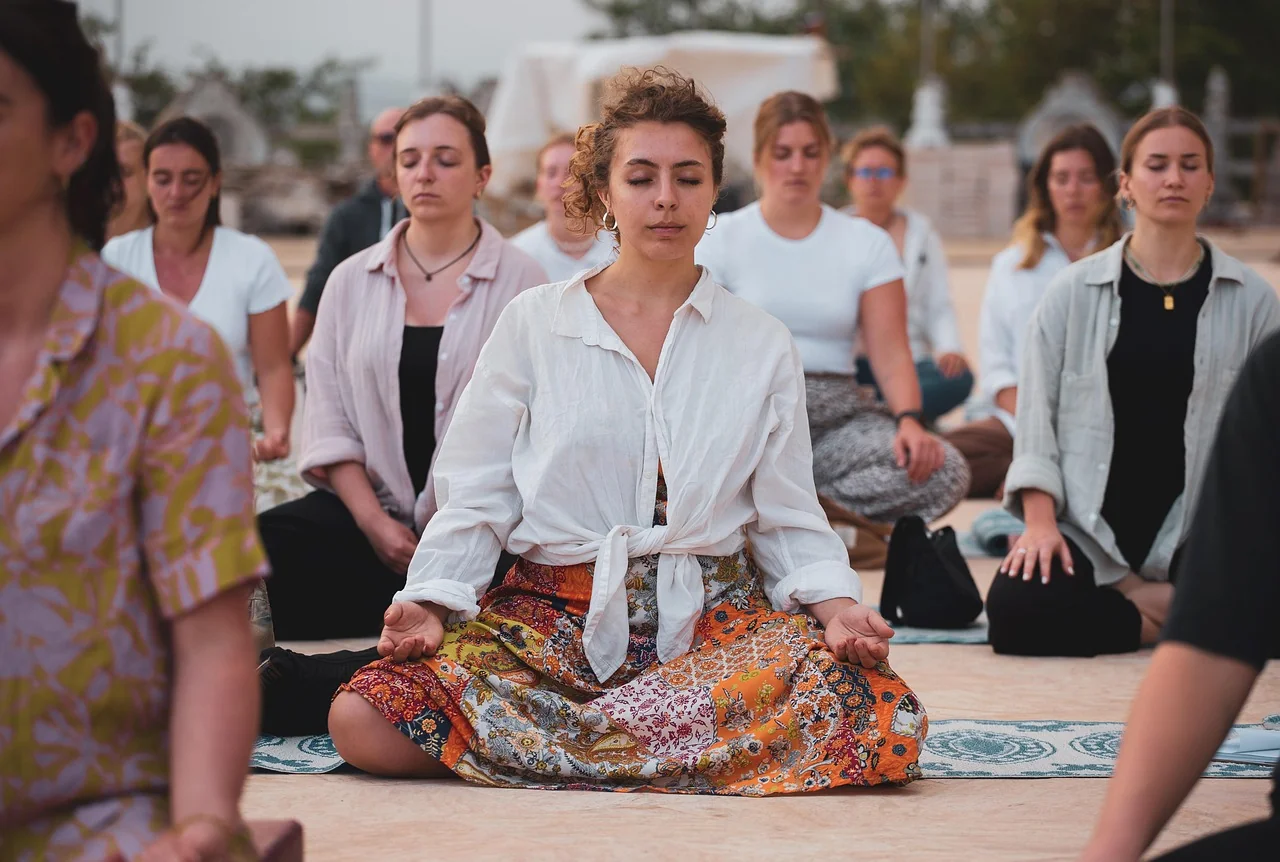Does your to-do list feel endless, your focus scattered, and your stress levels constantly simmering? You know you need a moment of calm, but the idea of finding 30 spare minutes to meditate feels like just another impossible task. What if the secret to a calmer, more focused mind wasn't a major time commitment, but a simple, consistent 5 minute daily meditation?
This small sliver of your day is a powerful tool for rewiring your brain for less stress and more clarity. Forget complicated techniques or uncomfortable postures; the true power lies in showing up each day. This guide is your practical roadmap to building that sustainable habit. We'll explore the science-backed benefits, walk you through a foolproof step-by-step practice, and show you how to seamlessly integrate this transformative five minutes into your busy life. Get ready to discover that the greatest peace can be found in the smallest moments.
Why a 5 Minute Daily Meditation is a Game-Changer
The biggest myth about meditation is that you need to empty your mind for an hour while sitting in a perfect lotus position. This all-or-nothing thinking is what stops most people before they even begin. The reality is that consistency trumps duration every single time.
A brief, daily practice is far more impactful than an hour-long session you only manage once a month. Your brain learns through repetition. By returning to a state of mindful awareness for just five minutes each day, you are effectively training your neural pathways. You're teaching your brain to default to a calmer, more observant state, even when you're not formally meditating.
This approach is a masterclass in habit stacking. It’s not about carving out a huge block of time you don’t have; it’s about attaching this new habit to an existing one. Think of it like brushing your teeth—a non-negotiable, brief act of hygiene for your mind. By making the commitment small and achievable, you eliminate the resistance and excuses, making it a practice you can actually stick with for life.
The Science-Backed Benefits of a Short Daily Practice
You might wonder if five minutes can really make a difference. The resounding answer from neuroscience and psychology is yes. This isn't just a placebo effect; it's a physiological shift with documented outcomes.
Reduces Cortisol Levels: Cortisol is your body's primary stress hormone. Research has shown that even short bouts of meditation can significantly lower cortisol production, dialing down your body's "fight or flight" response and promoting a state of relaxation.
Enhances Focus and Attention: Our modern world is a factory for distraction. Meditation is the ultimate focus training. It strengthens the prefrontal cortex, the part of your brain responsible for concentration. Each time you gently guide your wandering attention back to your breath, you're doing a rep for your focus muscles.
Improves Emotional Resilience: Meditation doesn't stop you from feeling difficult emotions, but it changes your relationship with them. It creates a crucial pause between a triggering event and your reaction. This space allows you to respond with intention rather than erupting on autopilot, giving you greater control over your emotional landscape. A practice like a 5 minute loving-kindness meditation is particularly powerful for cultivating compassion.
Boosts Sleep Quality: A racing mind is the number one enemy of good sleep. A simple five-minute meditation before bed can calm your nervous system, slow your heart rate, and signal to your body that it's time to rest. It's a powerful natural remedy for insomnia and restless nights.
Increases Self-Awareness: This daily check-in is a chance to listen to yourself without judgment. You become more attuned to your thought patterns, physical tensions, and emotional states. This heightened awareness is the first step toward making positive changes in your life.
Getting Started: Your Pre-Meditation Checklist
Before you dive into your first session, a little preparation can make the experience smooth and frictionless. The goal is to remove any potential obstacles.
Choosing Your Space and Time
You don't need a dedicated meditation room. A quiet corner of your bedroom or living room is perfect. The key is consistency in location, as it helps cue your brain for practice.
Timing is more critical. Anchor your meditation to an existing part of your routine to make it stick.
- Morning: Right after you wake up, before checking your phone. This sets a calm, centered tone for the entire day. A 5 minute morning meditation for gratitude is a perfect way to start your day with positivity.
- Lunch Break: A perfect way to reset and dissociate from morning stress before tackling the afternoon.
- Evening: Right after you get home from work, to transition out of "work mode."
- Before Bed: To quiet your mind and prepare your body for deep, restorative sleep.
Posture and Tools for Success
Comfort is paramount. You do not need to sit on the floor.
- Sit in a Chair: Sit upright with your feet flat on the floor and your back supported, but not slumped. This promotes alertness.
- Use a Cushion: If you prefer the floor, sit on a cushion to elevate your hips, allowing your knees to rest comfortably below them.
- Keep Your Spine Straight: Imagine a string pulling the crown of your head gently toward the ceiling. This opens your diaphragm for easier breathing.
- Rest Your Hands: Place them comfortably on your knees or in your lap.
For tools, all you truly need is a timer. Use your phone's timer (set to a gentle alarm) or a dedicated meditation app that offers free 5 minute meditation sessions if you prefer more structure.
A Step-by-Step Guide to Your 5 Minute Daily Meditation
Here is a simple, powerful technique centered on the breath. This is a foundational practice that anyone can follow. Read through the steps once, then set your timer and give it a try. For a more structured approach, you can also follow a 5 minute meditation script.
Minute 1: Arrive and Get Comfortable
Sit in your chosen spot and set your timer for five minutes. Take a few moments to settle into your posture. Feel the points of contact your body makes with the chair or cushion—your feet on the floor, your hands on your legs. Close your eyes or lower your gaze. Take two or three deep, intentional breaths, inhaling through your nose and exhaling through your mouth with a sigh. This signals to your mind and body that it's time to begin.
Minute 2-4: Anchor Your Attention (The Core Practice)
Now, allow your breath to return to its natural rhythm. Bring your full attention to the physical sensation of your breathing. Pick a single anchor point:
- The cool air entering your nostrils and the warm air leaving them.
- The gentle rise and fall of your chest.
- The expansion and contraction of your abdomen.
Your only task is to rest your awareness on this sensation. You are not trying to control the breath, just observing it.
Your mind will wander. This is not a failure; it is the entire point of the practice. The moment you realize your attention has drifted to a thought, a sound, or a bodily sensation, simply acknowledge it without judgment. Gently and kindly, guide your focus back to the sensation of your breath. This act of noticing and returning is like a bicep curl for your brain—it’s where the real strengthening happens.
Minute 5: Gently Expand and Close
For the final minute, gently release your tight focus on the breath. Expand your awareness to include your entire body. Feel the space you're in, notice any sounds in the room, and become aware of your body as a whole. Sit in this open, spacious awareness for a few moments.
When your timer chimes, don't jump up immediately. Slowly wiggle your fingers and toes. Gently open your eyes if they were closed. Take one more deep breath, and notice how you feel before you smoothly transition back into your day.
Overcoming Common Meditation Challenges
It’s normal to face hurdles, especially in the beginning. Recognizing them as part of the process is key.
"I Can't Stop Thinking." This is the most common experience. You are not failing at meditation when you have thoughts; you are succeeding each time you notice them and return to your breath. The goal is not thoughtlessness, but mindful awareness of your thoughts.
"I Feel Restless or Impatient." The body and mind often rebel against stillness. Acknowledge the feeling of impatience with curiosity—"Ah, restlessness is here"—and see if you can relax around it without needing to move. If the urge is too strong, make a tiny adjustment and return to your breath.
"I Fall Asleep." This is very common, especially if you're meditating while tired or lying down. Try meditating in a more upright posture, with your eyes open and a soft gaze. A morning practice can also help avoid this.
Making Your 5 Minute Practice a Lifelong Habit
The magic is in the daily repetition. Here’s how to make it stick.
Commit to a "Don't Break the Chain" Method. Mark an "X" on a calendar for each day you meditate. The visual chain of success is a powerful motivator to keep it going.
Start a Meditation Journal. After each session, jot down one sentence. How did you feel before? How do you feel after? This builds a record of the benefits, reinforcing your motivation.
Be Kind to Yourself. If you miss a day, or even a week, simply begin again. There is no room for guilt or self-criticism in a sustainable practice. The next five-minute session is always available to you.
Find a Community or Use an App. Consider using an app for guided meditations or connecting with a friend who also wants to build a habit. A little external accountability can work wonders.
A five-minute daily meditation is a profound act of self-care. It is a small investment with compounding returns for your mental clarity, emotional balance, and overall well-being. This simple practice is your portable sanctuary, available anytime, anywhere. All it asks is for you to show up, breathe, and begin again. Your calmer, more focused mind is just five minutes away.
In conclusion, dedicating just five minutes each day to meditation is a profoundly accessible and transformative practice. This small investment of time can yield significant returns, from reduced stress and enhanced emotional regulation to improved focus and a greater sense of overall well-being. The key is consistency, not duration; the simple act of returning daily to your breath or a chosen point of focus builds the mental muscle for mindfulness that strengthens over time. Remember that the goal is not to empty the mind, but to observe it without judgment, gently guiding your attention back each time it wanders. This practice equips you with a portable tool for calm, available whenever life's pressures mount. Start tomorrow. Find a quiet moment, set a timer, and take this small, powerful step toward a more centered and peaceful life. Your journey toward a calmer mind begins with a single, mindful breath.


